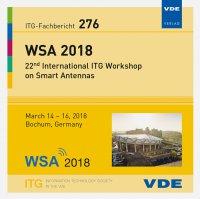A Robust Time-Domain Beam Alignment Scheme for Multi-User Wideband mmWave Systems
Konferenz: WSA 2018 - 22nd International ITG Workshop on Smart Antennas
14.03.2018 - 16.03.2018 in Bochum, Deutschland
Tagungsband: WSA 2018
Seiten: 7Sprache: EnglischTyp: PDF
Persönliche VDE-Mitglieder erhalten auf diesen Artikel 10% Rabatt
Autoren:
Song, Xiaoshen; Haghighatshoar, Saeid; Caire, Giuseppe (Communications and Information Theory Group (CommIT), Technische Universität Berlin, Germany)
Inhalt:
Millimeter wave (mmWave) communication with large array gains is a key ingredient of next generation (5G) wireless networks. Effective communication in mmWaves usually depends on the knowledge of the channel. We refer to the problem of finding a narrow beam pair at the transmitter and at the receiver, yielding high Signal to Noise Ratio (SNR) as Beam Alignment (BA). Prior BA schemes typically considered deterministic channels, where the instantaneous channel coefficients are assumed to stay constant for a long time. In this paper, in contrast, we propose a time-domain BA scheme for wideband mmWave systems, where the channel is characterized by multi-path components, different delays, Angle-of-Arrivals/Angle-of-Departures (AoAs/AoDs), and Doppler shifts. In our proposed scheme, the Base Station (BS) probes the channel in the downlink by some sequences with good autocorrelation property (e.g., Pseudo-Noise (PN) sequences), letting each user estimate its best AoA-AoD that connects the user to the BS with two-sided high beamforming gain. We leverage the sparse nature of mmWaves in the AoA-AoD-time domain, and formulate the BA problem as a Compressed Sensing (CS) of a non-negative sparse vector. We use the recently developed Non-Negative Least Squares (NNLS) technique to efficiently find the strongest path connecting the BS and each user. Simulation results show that the proposed scheme outperforms its counterpart in terms of the training overhead and robustness to fast channel variations.


